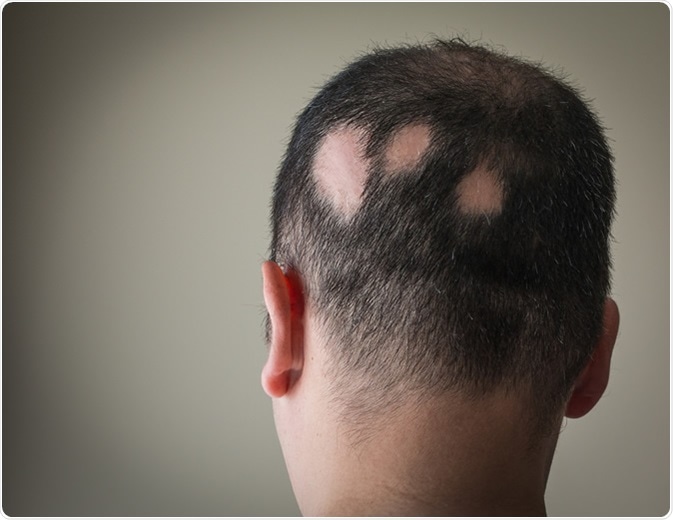Alopecia is the medical term for hair loss. Hair loss may occur naturally or it may be related to disease or the use of certain medications. Symptoms of alopecia vary depending on the cause of the condition and range from a small bald patch to a complete loss of all body hair.
Alopecia Types
There a number of different types of alopecia and some of the more common forms are described in more detail below.
Male-Pattern baldness
This is the most common form of alopecia and it affects around 50% of men by time they reach the age of 50. Also called androgenic or androgenetic alopecia, this form of baldness is hereditary and thought to be associated with having an excess of a certain hormone, which has an effect on hair follicles. In male-pattern baldness, the hairline typically recedes and the hair becomes thin. The hair loss usually begins while a man is in his late 20s or early 30s.
Female-Pattern baldness
Baldness can also affect women. Scientists are unclear about whether female-pattern baldness is hereditary and what the causes are, but it seems to be more likely to affect post-menopausal women, possibly as a result of hormonal changes.
Alopecia areata
Also referred to as patchy baldness, the symptom of this condition is bald patches that resolve and then recur. It occurs suddenly and recurrence may be frequent. Men, women and children of any age may be affected, although it is most common among teenagers and young adults. Alopecia areata can affect any part of the body, although usually the patches occur on the scalp. It is caused by an immune system disorder and people with autoimmune conditions are more likely to be affected. In one fifth of cases, alopecia areata is hereditary and there is a family history of the condition.

Alopecia Aerata - Image Credit: Alex Papp / Shutterstock
Scarring alopecia
Also called cicatricial alopecia, this type of alopecia refers to permanent hair loss caused by rare conditions such as scleroderma and discoid lupus. The hair follicles are completely destroyed and hair does not grow again. The condition affects both males and females and is more common among adults than children. About 7% of alopecia cases are scarring alopecia.
Anagen effluvium
This is a form of hair loss that may affect the whole body, scalp and face. Anagen effluvium is most caused commonly by the chemicals used to treat cancer in chemotherapy and, in some cases, other cancer therapies such as radiotherapy or immunotherapy. The hair loss usually begins following a few weeks of chemotherapy, although not all of the chemicals used have this effect. The alopecia is usually temporary and hair begins to grow again about six months after treatment has stopped.
Telogen effluvium
This is a form of hair loss where more hair than usual falls out, causing the hair to thin in general rather than in patches. Head hair does feel thinner, but complete hair loss is unlikely. Other parts of the body are not generally affected. The condition is temporary and the hair does start to grow back after around six months in most cases. Telogen effluvium can be caused by the following:
- Extreme emotional or physical stress
- Intense physical stress
- Hormonal changes
- Chronic diseases such as cancer
- Dietary changes or crash dieting
- Severe infection
- Certain medications
Treatment
Male-pattern baldness is a normal part of growing older and does not require treatment because it is not harmful to health. However, the hair loss can still be distressing and there are some treatment approaches available for people who becoming distressed or losing self-confidence.
The medications finasteride and minoxidil can be used to treat male-pattern baldness and the latter is also a treatment for female-pattern baldness. These drugs are not guaranteed to improve hair loss and any positive effects only last for as long as the drugs are taken.
Alopecia areata may be treated with steroids or immunotherapy. The immunotherapy entails deliberately inducing an allergic response that triggers the growth of hair in bald areas.
Alopecia may also be treated using surgical methods such as hair transplant or implants. Alternatively, a person may decide to use a wig, which may be synthetic or made of real hair.
Hair transplant is a procedure that is mainly used to treat male-pattern baldness. Hair follicles are taken from the back of the head and transplanted into a bald area.
In scalp reduction surgery, part of the bald scalp at the crown of the head is removed and the nearby parts of skin that do have hair growth are sewn together to cover the area where the bald patch previously was.
Further Reading